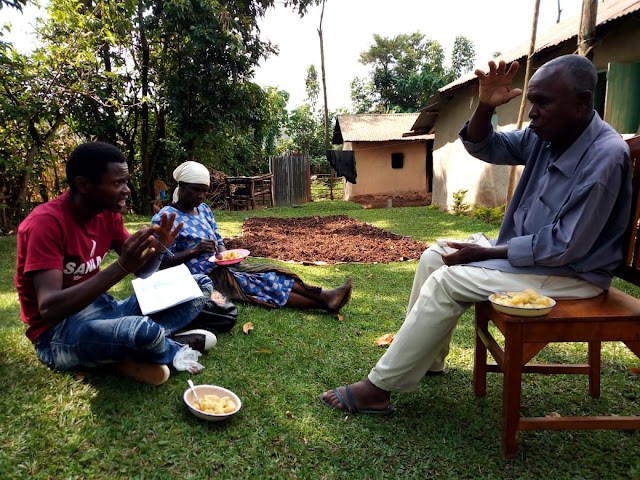Saniaga at Handidi
 |
| With Simon Amugongo and wife at his home in Handidi |
It is believed they arrived at Handidi in 1902 when Kaimosi Mission was started. The earliest known migrant called Adembesa.
Adembese became one of the askaris to a Kabras chief called Wa Kukha. Then, no one lived at Handidi, it was bushy. But Adembesa is said to have found another earlier migrant, a Saniaga identified as M'mugezi. Who welcomed him in the area. It would later be Vagihayo and Saniaga (written saniaka) who became majority there.
The very first settlement was at Handidi Primary. They paved for the construction of the school, patronized by Handidi Quaker Church (established 1919) by moving downwards.
Conflict was the main reason as to why the migrations from Maragoli though some followed on acquaintance basis.
Then, a foot path passed thinly in thickly forests from Maragoli to Lusui (Idakho) in the land of Chief Shivachi, through Lugose river, Khayega, shererwe river, Muranda (now Kiwanja Ndege), Senyende and to Isukha. Much as Kakamega was famous already, it was long to pass there and two, the fear to be caught and taken for forced labor made people abhor the way.
And it is mainly why World War 2 saw many of the migrants going back to Maragoli, their ancestry. Partly diseases and deaths. Running away from North Kavirondo administration, away from being recruited into Kenya African Rifles (KAR that birthed Keya, a name children would be called in remembrance).
Not all went back. Some stayed. Time passed. And when you needed only 5/- to register and be given land in 'scheme', Saniaga were hosted by their Handidi relatives on their way from Maragoli to Lugari and beyond. Just like some Maragoli grandfathers now thought there was no need for more land away, they too think it would have been wiser to have strove and gotten parcels equally. Too late when whom we call our fathers were shared pieces around and lol, too little!
I can make my children build (Better said 'nyara kwumbakiza wange mwana navuza yivi surinyara), says a Saniaga. But you won't do that for your child. Why? Where will the land be? Where will the children themselves be? As they also peer into the future, the elders remaining at Handidi, they say there may be little or no leadership from their offsprings. Each is on own different self-beating-path. Bad in report.
A way forward? A Saniaga Handidi Group. To encourage fellowship of members at Handidi and support collective approach to issues affecting them. That way a young one would not be so far linked and more of an Isukha than a Saniaga kin to another in the same locality.
And Saniaga at Handidi shall remain a resilient united people.
With Thanks
Comments
Post a Comment